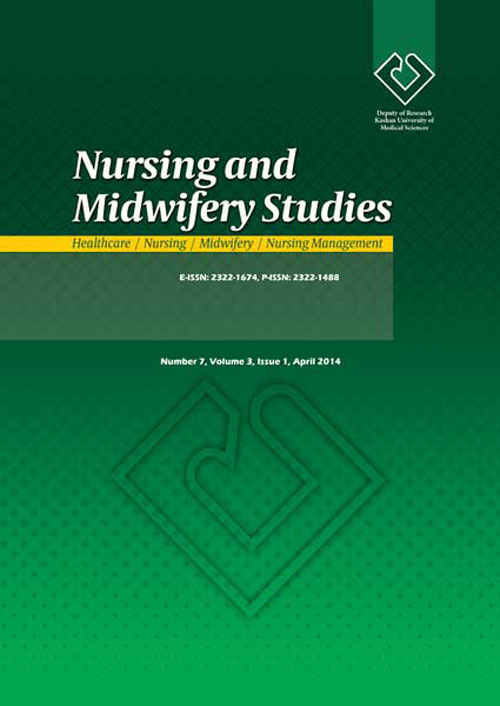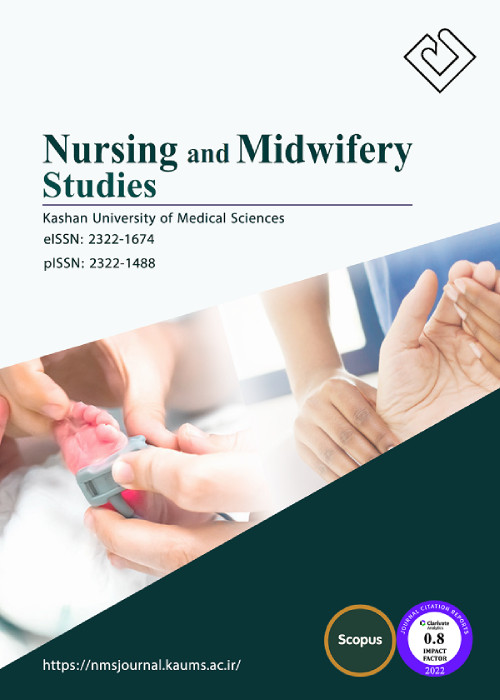فهرست مطالب

Nursing and Midwifery Studies
Volume:5 Issue: 2, Apr-Jun 2016
- تاریخ انتشار: 1395/05/13
- تعداد عناوین: 10
-
-
Page 3BackgroundThe world health organization guidelines for treatment of diarrhea in children emphasize on continued feeding together with prescription of oral rehydration solution (ORS) and supplementary zinc therapy. However, conflicting viewpoints exist regarding the optimal diet and dietary ingredients for children with diarrhea. Moreover, few studies have investigated the effect of rice soup along with ORS in the treatment of this disease..ObjectivesThis study aimed to explore effects of simultaneous taking of glucose oral rehydration solution (G-ORS) and rice soup in the treatment of acute diarrhea in 8 to 24-month-old children..
Patients andMethodsThis single-blind controlled clinical trial was conducted in the pediatric ward of 22nd of Bahman hospital, Gonabad, Iran between June 2013 and February 2014. Forty children aged 8-24 months with acute diarrhea were randomly assigned into an intervention group (G-ORS plus rice soup group) comprising 20 babies and a control group (G-ORS) of 20 children based on balanced blocking randomization. The variables under investigation were diarrhea duration, patient hospitalization, need for intravenous (IV) fluids and stool output frequency. Data was analyzed using independent samples t and chi-square test..ResultsAt the end of study, the time for treating acute watery diarrhea in the intervention and control groups were 21.10 ± 8.81 and 34.55 ± 5.82 hours (PConclusionsRice soup regimen was highly effective and inexpensive in the treatment of acute diarrhea in children. Thus, in addition to the common treatment by G-ORS, rice soup can be consumed simultaneously with G-ORS..Keywords: ORS, Rice, Diarrhea, Children -
Page 4BackgroundStudies have shown that educating mothers can improve their adaptation to pregnancy and motherhood roles. There are also studies that have investigated the effects of certain interventions on maternal-fetal attachment. However, studies on the effects of maternal adaptation training on maternal-fetal attachment in mothers with a history of fetal or baby loss are rare..ObjectivesThe aim of this study was to determine the effects of a pregnancy adaptation training package on maternal-fetal attachment in pregnant women with a history of baby loss..
Patients andMethodsThis quasi-experimental study was conducted on 60 pregnant women with previous fetal or neonatal death in 2014. The women were randomly divided into an experimental group (n = 30) and a control group (n = 30). The pregnant women in the experimental group received routine prenatal education in addition to four sessions of a pregnancy adaption training package. The control group received only routine prenatal education. The data were collected using a demographic questionnaire, Cranleys maternal-fetal attachment scale, and a prenatal self-evaluation questionnaire at the beginning and at the end of the study. The data analysis was conducted using the Mann-Whitney U, Wilcoxon, chi-square, Fishers exact, and spearman correlation coefficient tests..ResultsBefore the intervention, there were no statistically significant differences between the study and control groups in terms of maternal-fetal attachment (P = 0.280) and adaptation to pregnancy (P = 0.883). However, following the intervention, the mean score of the maternal-fetal attachment was significantly higher in the experimental group, when compared with the control (77.57 ± 7.23 vs. 61.53 ± 2.62; P = 0.001). In addition, the mean post-intervention adaptation to pregnancy score was significantly lower in the experimental group than in the control group (118.89 ± 8.12 vs. 126.38 ± 4.17; P = 0.001)..ConclusionsThe pregnancy adaptation training package increased the adaptation and maternal-fetal attachment scores in pregnant women with a history of baby loss..Keywords: Adaptation, Attachment, Baby Loss, Educational Package -
Page 5BackgroundWith the integration of the evaluation of patient satisfaction in the overall assessment of healthcare services, authorities can be assured about the alignment of these services with patient needs and the suitability of care provided at the local level..ObjectivesThis study was conducted in 2013 in Zahedan, Iran, in order to assess the psychometric properties of the Iranian version of the mackey childbirth satisfaction rating scale (MCSRS)..
Patients andMethodsFor this study, a methodological design was used. After translating the MCSRS and confirming its initial validity, the questionnaires were distributed among women with uncomplicated pregnancies and no prior history of cesarean section. The participants had given birth to healthy, full-term, singletons (with cephalic presentation) via normal vaginal delivery at hospitals within the past six months. Cronbachs alpha and test-retest (via the intraclass correlation coefficient) were applied to analyze the internal consistency and reliability of the scale. Moreover, the validity of the scale was tested via exploratory factor analysis, confirmatory factor analysis, and convergent validity..ResultsThe MCSRS consists of six subscales. Through the process of validation, two partner-related items (partner subscale) of the scale were excluded due to cultural barriers and hospital policies. Cronbachs alpha for the total scale was 0.78. It ranged between 0.70 and 0.86 for five subscales, and was 0.31 for the baby subscale. Factor analysis confirmed the subscales of nurse, physician, and baby, which were identified in the original scale. However, in the translated version, the self subscale was divided into two separate dimensions. The six subscales explained 70.37% of the variance. Confirmatory factor analysis indicated a good fitness for the new model. Convergent validity showed a significant correlation between the MCSRS and the SERVQUAL scale (r = 0.72, PConclusionsThe study findings indicated the Farsi version of the MCSRS is a reliable and valid instrument. However, according to the reliability assessment and factor analysis, the baby and self subscales need further revisions..Keywords: Patient Satisfaction, Childbirth, Psychometric Tests -
Page 6Background
Nurses require certain skills for progression in their field. Identifying these skills can provide the context for nursing career advancement..
ObjectivesThis study aimed to identify the skills needed for nurses career advancement..
Materials And MethodsA qualitative approach using content analysis was adopted to study a purposive sample of eighteen nurses working in teaching hospitals affiliated with the Qazvin, Shahid Beheshti, and Iran Universities of Medical Sciences. The data were collected through semi-structured interviews, and analyzed using conventional content analysis..
ResultsThe three themes extracted from the data included interpersonal capabilities, competency for career success, and personal capacities. The results showed that acquiring a variety of skills is essential for career advancement..
ConclusionsThe findings showed that personal, interpersonal, and functional skills can facilitate nurses career advancement. The effects of these skills on career advancement depend on a variety of conditions that require further studies..
Keywords: Career Mobility, Nursing, Qualitative Research -
Page 7BackgroundCirculatory management is a critical issue in pre-hospital transportation phase of multiple trauma patients. However, the quality of this important care did not receive enough attention..ObjectivesThe aim of this study was to investigate the quality of pre-hospital circulatory management in patients with multiple trauma..
Patients andMethodsThis was a cross-sectional study conducted in 2013. The study population consisted of all patients with multiple trauma who had been transferred by emergency medical services (EMS) to the central trauma department in Kashan Shahid Beheshti medical center, Kashan, Iran. We recruited a convenience sample of 400 patients with multiple trauma. Data were collected using the circulatory assessment questionnaire and controlling hemorrhage (CAQCH) that were designed by the researchers and were described by using frequency tabulations, central tendency measures, and variability indices. The chi-square test was used to analyze the data..ResultsThe study sample consisted of 263 males (75.2%); 57.75% had lower levels of education and 28.75% were workers. The most common mechanism of trauma was traffic accident (85.4%). We found that the quality of circulatory management was unfavorable in 61% of the cases. A significant relationship was observed between the quality of circulatory management and type of trauma and staffs employment status..ConclusionsThe quality of pre-hospital circulatory management provided to patients with multiple trauma was unfavorable. Therefore, establishment of in-service training programs on circulatory management is recommended..Keywords: Quality, Circulatory, Pre, hospital Care, Multiple Trauma -
Page 8BackgroundStudies have shown that family caregivers of hemodialysis patients experience high levels of burden. However, these caregivers are often neglected, and no studies are available on the effectiveness of coping strategies on the burden of care among these caregivers..ObjectivesThis study aimed to examine the effectiveness of problem-focused coping strategies (communication skills, anger management, and deep breathing) on the burden on caregivers of hemodialysis patients..
Patients andMethodsA randomized controlled clinical trial was conducted on 76 family caregivers of hemodialysis patients referred to Shahid Hasheminejad hemodialysis center in Tehran, Iran. The subjects were equally allocated into two groups of 38. Through a coin-tossing method, caregivers of patients who referred on even or odd days of the week were randomly assigned into the intervention group or the control group, respectively. The intervention group received four training sessions on problem-focused coping strategies, but the control group did not receive any intervention. Both groups answered the caregivers burnout inventory at the start and six weeks after the last educational session. Descriptive statistics, chi-square, Fishers exact test, independent-samples t-test, and Mann-Whitney U test were used to analyze the data..ResultsThe majority of caregivers (54%) were in the age range of 35 - 55 years, female (68.4%), and married (70%). No significant difference was found between the baseline mean caregivers burden scores of the intervention and control groups (88.56 ± 11.74 vs. 84.97 ± 15.13, P = 0.308). However, the mean caregivers burden in the intervention group decreased, and the two groups were significantly different at the end of the study (58.77 ± 6.64 vs. 87.84 ± 11.74, PConclusionsThe current study showed the effectiveness of problem-focused coping strategies on reducing the burden on caregivers of hemodialysis patients. Authorities and policymakers in the healthcare system are responsible for developing strategies to integrate educational programs, such as the program implemented in the current study, into the countrys healthcare system..Keywords: Teaching, Coping Skill, Burden of Care, Caregivers, Hemodialysis, Patients -
Page 9BackgroundClinical training is an integral part of nursing education; however, some studies have shown that it is not always efficient..ObjectivesThis study aimed to find out the factors that can impede nursing students clinical learning..Materials And MethodsIn this qualitative study, data were collected via reflective journal writing. Purposeful sampling was used, and 12 senior nursing students were recruited to the study. The data were analyzed using a content analysis method..ResultsThree main categories were derived, including inappropriate communication, ineffective role models, and theory-practice gaps. Students perceived that inappropriate communication between instructors, staff members, and students had the greatest impact on student learning. The competence of clinical instructors and staff is an important factor affecting students training. The clinical learning environment does not always integrate theory and practice together..ConclusionsNursing students did not experience effective clinical learning. Having expert instructors and supportive communication are important factors in creating a clinical learning environment..Keywords: Nursing, Student, Communication, Learning, Practice, Qualitative Research
-
Page 10BackgroundDepression is the most frequent psychiatric disorder among the elderly. Obstructive sleep apnea (OSA) is a chronic and prevalent disease that has an ambiguous role in triggering depression. Several researches with contradictory findings have been performed about the association between OSA and depression..ObjectivesThis study aimed to investigate the association between OSA and depression among elderly..
Patients andMethodsA total of 350 home residing elderly took part in this case-control study. The participants were selected using clustering method. All cases were divided into two groups of depressed and non-depressed using the geriatric depression scale (GDS). Then they were matched in age, gender, education and body mass index (BMI). Berlin questionnaire (BQ) was used to diagnose OSA. Data analysis was performed using Mann-Whitney U test, t-test, Chi-square and Fishers exact tests and odds ratio..ResultsTotally, 60.6 % of depressed group and 18.9 % of non-depressed group were in high risk for OSA. A significant association was found between OSA and depression (PConclusionsOSA was associated with depression among the elderly patients. Given the high prevalence of OSA in older adults, implementation of screening methods is necessary to identify people at high risk of OSA..Keywords: Obstructive Sleep Apnea, Depression, Elderly


